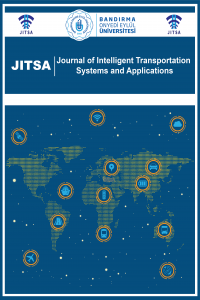Elektrik tahrikli bir tren hareketinin benzetim ortamında modellenmesi ve modelin gerçek bir hat üzerinde doğrulanması
Ulaşım ve taşımacılık günümüz dünyasında önemli bir yere sahiptir. Gelişen teknoloji ile yolculuk sürelerinin kısalması ve büyüyen nüfus kentsel hareketliliğin artmasına sebep olmaktadır. Hareketlilik yaşam kalitesinin anahtarı ve ekonominin ana unsuru olmakla birlikte ulaşımın her geçen gün gelişmesine paralel olarak toplu taşımanın çevreye olan etkileri ve enerji tüketimi de aynı oranda artmaktadır. Bir raylı sistemi oluşturan parçaların enerji tüketim seviyeleri farklıdır. Açıktır ki enerji tüketiminde en büyük pay treni itmek için üretilen cer kuvvetinin sağlanması aşamasına aittir. Cer enerji tüketimini en ask indirmek için çeşitli optimizasyon yöntemleri mevcuttur. Ancak bunu başarabilmek için gerçek bir tren hareketini benzeten bir tren hareket benzetimine (THB) ihtiyaç duyulmaktadır. Bu çalışmada, bir raylı taşıta ait karakteristik özellikler, raylı sistem ağındaki yol özellikleri ve işletime bağlı kısıtlar göz önünde bulundurularak, taşıta ait model MATLAB benzetim ortamında gerçeklenmiştir. Geliştirilen THB ile gerçek tren hareketinin ne kadar doğrulukla gerçekleştirildiğinin tespit edilebilmesi için, Metro İstanbul A.Ş. işletmesine bağlı olan M3 Metro hattındaki trenlerde saha testleri yapılmıştır. Saha ve THB verilerinin karşılaştırılması sonucunda, THB’nin enerji tüketiminde %95, sürede %98, maksimum cer kuvveti ile aynı mesafede ulaşılan hızda %99, boşta giderek ulaşılan hızda %94 ve frenleme mesafesinde %97 doğrulukla, gerçek tren hareketlerini benzetebildiği ortaya koyulmuştur.
Anahtar Kelimeler:
Raylı Sistemler, Modelleme, MATLAB, Benzetim, Vaka Çalışması
___
- Hillmansen, S., and Roberts, C. (2007). Energy storage devices in hybrid railway vehicles: A kinematic analysis. Proceedings of the Institution of Mechanical Engineers, Part F Journal of Rail and Rapid Transit, vol. 221, pp. 135-143, Jan, 2007, doi:10.1243/09544097JRRT99
- Mellitt, B., Goodman, C.J., and R. I. M. Arthurton, R.I.M. (1978). Simulator for studying operational and power-supply conditions in rapid-transit railways. Proceedings of the Institution of Electrical Engineers, vol. 125, pp. 298-303, Apr, 1978, doi: 10.1049/piee.1978.0075
- Cheng, J.X., and Howlett, P. (1993). Anote on the calculation of optimal strategies for the minimization of fuel consumption in the control of trains. IEEE Transactions on Automatic Control, vol. 38, no. 11, pp. 1730–1734, Nov, 1993 doi: 10.1109/9.262051
- Howlett, P. (1996). Optimal strategies for the control of a train. Automatica, vol. 32, no. 4, pp. 519–532, 1996,doi: 10.1016/0005-1098(95)00184-0
- Albrecht, A., Howlett, P., Pudney, P., Vu, X. and Zhou, P. (2015). The key principles of optimal train control—Part 1: Formulation of the model, strategies of optimal type, evolutionary lines, location of optimal switching points. Transportation Research Part B: Methodological, vol. 94, pp. 482–508, 2016, doi: 10.1016/j.trb.2015.07.023
- Arıkan, Y., Şen, T., ve Çam, E. (2020). A study of energy efficiency in rail vehicles. El-Cezerî Journal of Science and Engineering, vol.7, no. 1, (223-235), 2020, doi: 10.31202/ecjse.622358
- Sanchis, I.V. ve Zuriaga, P.S. (2016). An energy-efficient metro speed profiles for energy savings: application to the Valencia metro. XII Conference on Transport Engineering, CIT 2016, 7-9 Jun. 2016, Valencia, Spain, pp 226-233
- Wang, W., Zeng, X., Shen, T. ve Liu, L. (2018). Energy-efficient speed profile optimization for urban rail transit with considerations on train length. 21st International Conference on Intelligent Transportation Systems (ITSC), Maui, Hawaii, USA, Nov.4-7, 2018
- Hu, P., Chen, R. ve Li, H. (2012). Train operation traction energy calculation and saving in urban rail transit system. Second International Conference on Instrumentation & Measurement, Computer, Communication and Control, 2012, doi: 10.1109/IMCCC.2012.125
- Keskin, K. ve Karamancıoğlu, A. (2017). Energy-efficient train operation using nature-inspired algorithms. IFAC (International Federation of Automatic Control), 2017, doi: org/10.1155/2017/6173795
- Lu, S., Weston, P., Hillmansen, S., Gooi, H. B. and Roberts, C. (2014). Increasing the Regenerative Braking Energy for Railway Vehicles. IEEE Transactions on Intelligent Transportation Systems, vol. 15, pp. 2506-2515, 2014, doi:10.1109/TITS.2014.2319233
- Chen, E., Bu, B., ve Sun, W. (2015). An energy-efficient operation approach based on the utilization of regenerative braking energy among trains. IEEE 18th International Conference on Intelligent Transportation Systems, 2015, doi:10.1109/ITSC.2015.419
- Su, S., Li, X., Tang, T. ve Gao, Z. (2013). A subway train timetable optimization approach based on energy-efficient operation strategy. IEEE transactions on intelligent transportation systems, vol. 14, no. 2, june 2013, doi:10.1109/TITS.2013.2244885
- Keskin K. ve Karamancıoğlu, A. (2016). Energy efficient motion control for a light rail vehicle using the big bang big crunch algorithm. 14-th IFAC Symposium on Control in Transportation Systems, Istanbul,2016, doi: 10.1016/j.ifacol.2016.07.824
- Rangelov, V.N., (2012). Gradient modelling with calibrated train performance models. COMPRAIL,vol: 127, 10.2495/CR120111, September 2012. Su, S., Tang, T., ve Wang, Y. (2016). Evaluation of strategies to reducing traction energy consumption of metro systems using an optimal train control simulation model. Article in Energies, February 2016, doi: org/10.3390/en9020105
- ISSN: 2636-820X
- Yayın Aralığı: Yılda 2 Sayı
- Başlangıç: 2018
- Yayıncı: Bandırma Onyedi Eylül Üniversitesi
Sayıdaki Diğer Makaleler
Şişli ilçesindeki trafik kazalarının coğrafi bilgi sistemleri ile incelenmesi
Mert ERSEN, Ali Hakan BÜYÜKLÜ, Semra ERPOLAT TAŞABAT
Bağlantılı Mikromobilite Altyapısını Mevcut Toplu Taşıma Sistemine Entegrasyonu
Kavşak yaklaşımında araçların A-sütunlarının önemi
Yeni Nesil Mobil İletişim Sistemlerinin Gemi Kara Arasındaki Deniz Haberleşmesinde Kullanım Olanağı
Akıllı ulaşım sistemlerinde siber saldırılar ve önlemler
Dispeç Kaynaklı Aksaklıkların Diğer Operasyon Birimlerine Etkisi
Hasan SEMİZ, Ebru ARIKAN ÖZTÜRK
Kent Ulaşımında Mikromobilite Çözümlerine Lokasyon Analitiği Yaklaşımı
